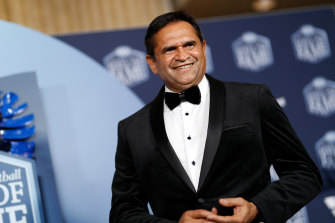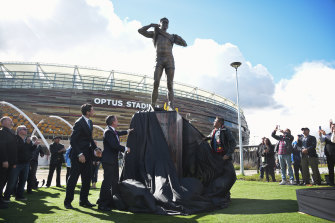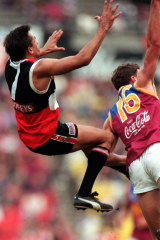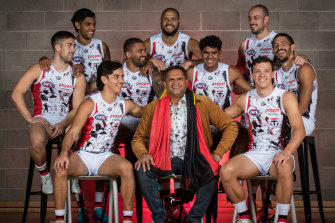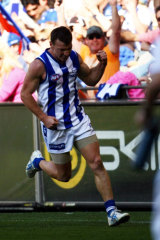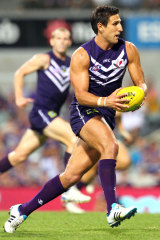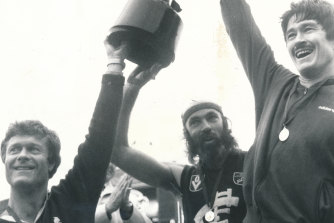Hall of Fame: Winmar gets a guernsey at last
Nicky Winmar at the Australian Football Hall of Fame dinner.Credit:Getty Images
There is a bittersweet aspect to the way new Australian Football Hall of Fame inductee Nicky Winmar has been fixed in the consciousness of footy and of Australia by a single image.
You’ll know it. Anyone with the merest passing interest in footy or race relations in this country in the past 30 years must. It never fades.
Having endured vile day-long racist abuse from the crowd at Victoria Park while spurring his Saints to a rare win over Collingwood there in 1993, a defiant Winmar pulled up his jumper and pointed proudly at his bared black skin.
Nicky Winmar (right) unveils his statue in Perth.Credit:Marta Pascual Juanola
Photographer Wayne Ludbey’s famous snap ran on the front page of the next day’s Sunday Age and since has been reproduced as a painting, a mural and a statue, and celebrated in an Archie Roach song. The jumper has become a museum artefact.
Nicky Winmar flies.Credit:Joe Armao
“You’ve changed my life,” Winmar said to Ludbey decades later, “but you have to realise I relive that moment over and over.”
So many other images from his 17-year senior career could have defined Winmar. It could have been of him clambering up the back of a pack to take another brilliant mark, including one in 1992 that became mark of the year. It could have been him floating to the fall of the ball and screwing another goal around his body: left foot or right, it was all the same.
It could have been of him launching another of the now almost extinct torpedo punts from a muddy centre square and carrying the goal line again.
Winmar is in both the St Kilda and Indigenous teams of the 20th century. At his best, he was a sublime footballer, light, balanced and skilful, the acme of what was then a recognisably West Australian style. Go back now and you can hear the commentators’ voices rise with the crowd’s in anticipation whenever he went near the ball.
Less remembered about that day at Victoria Park was that Winmar got two Brownlow votes. Teammate and Indigenous brother Gilbert McAdam got the three. Also less remembered is that Winmar did not play for the next three weeks because of a fallout with the club. There would be others.
Nicky Winmar with the nine Indigenous players on St Kilda’s 2022 list.Credit:Darrian Traynor/Getty Images
Winmar was not a crusader like Michael Long and Adam Goodes after him. He was a catalyst. In some ways, it made his burden heavier and his road harder. In 1990, he was suspended for 10 weeks for eye-gouging Dermott Brereton, who subsequently apologised for racial abuse towards him. In 1999, he was the target of an appalling Sam Newman blackface sketch on The Footy Show.
It was only a generation ago, but it was another time; as much can be told by the goal umpires in ties and white coats and hats in all the Winmar clips. With less support than he would get now, Winmar’s footy journey was tempestuous, and his life since has had its ups and downs.
Evergreen: Brent Harvey.Credit:John Donegan
This might explain why it has taken more than 20 years for him to achieve Hall of Fame honours. Now, though, it’s official: Winmar took his marks and he made his mark. No history of Australian rules footy could be written without him.
Other, less complex images spring to mind of this year’s other inductees. There’s Brent “Boomer” Harvey flitting and bouncing around the North Melbourne packs for 21 years. As the VFL/AFL games record-holder, he demanded a seat at the table.
And there’s Matthew Pavlich, towering at both ends of the ground for 353 Fremantle games, claiming six best and fairests and five All-Australians. One of his All-Australian guernseys was at full-back, two others at centre half-forward – the epitome of key position class.
Harvey and Pavlich both have been welcomed into through the Hall of Fame portals at the first allowable opportunity, five years after retirement.
And here’s Mike Fitzpatrick, whose name to most under-50s must conjure up a neatly groomed, bookish, banker-ish AFL commissioner and chairman, which he was for nine years.
Matthew Pavlich in full stride.Credit:Suppllied.
But before that, he played for Subiaco and was a triple-premiership ruckman and captain for Carlton, and it might have been more if he had not taken a near two-year sabbatical to complete a Rhodes Scholarship (see bookish, above). He also played interstate footy for both WA and Victoria, captaining the latter.
A commission chairman will never satisfy all, nor will a Carlton ruckman, but Fitzpatrick’s CV now adds up to a Hall of Fame plinth. It only took him 40 years.
Pausing to note that it is the Australian Football Hall of Fame, not AFL, it is spreading its favours ever wider. There are guernseys this year for Michael Taylor, Bill Dempsey, Terry Cashion and Ted Tyson.
Taylor brings to mind the image of an understated, but dependable defender with Norwood and Collingwood in the ’80s. The rest we will have to imagine from outlines.
Dempsey, a rugged ruckman, played an estimated nearly 500 games for West Perth and the Darwin Buffaloes (where record-keeping was scanty), turning out all year round for more than a decade. He is in the WA, NT and Indigenous teams of the century. He’d probably suit up for them all still, though he is 80.
The late Ted Tyson kicked 1203 goals in 228 games for West Perth, at the Hudson-esque rate of 5.25. And the late Terry Cashion won seven best and fairests as a rover for four Tasmanian clubs on either side of World War II and is in the Tasmanian team of the century. Look it up: it would beat most other all-time state teams. Put it this way: Matthew Richardson is relegated to the bench.
Mike Fitzpatrick (right) with coach David Parkin and star defender Bruce Doull and the 1982 premiership cup.Credit:The Age Archives
The Hall’s final order of 2022 business was to elevate Russell Ebert to Legend status. Ebert, who died last year, is regarded as Port Adelaide’s greatest ever and his mantelpiece would have groaned with trophies.
His name will revive a thousand memories for Port people, but one lives on in this column’s mental picturebook: Port Power in its final hitout at Alberton before what would become its first premiership in 2004, and right there among them, in full (prison bar) kit and boots, 55-year-old Ebert and his gammy hips, doing whatever least he could for the Port cause.
Most Viewed in Sport
From our partners
Source: Read Full Article
